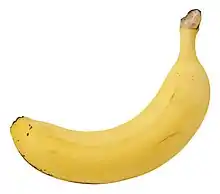| Musa | |
|---|---|
 | |
| Banana plants, Kanaha Beach, Maui | |
| Scientific classification | |
| Kingdom: | Plantae |
| Clade: | Tracheophytes |
| Clade: | Angiosperms |
| Clade: | Monocots |
| Clade: | Commelinids |
| Order: | Zingiberales |
| Family: | Musaceae |
| Genus: | Musa L.[1] |
| Type species | |
| Musa acuminata | |
| Species | |
|
Around 80, see text. | |
Musa is one of three genera in the family Musaceae. The genus includes 83 species of flowering plants producing edible bananas and plantains. Though they grow as high as trees, banana and plantain plants are not woody and their apparent "stem" is made up of the bases of the huge leaf stalks. Thus, they are technically gigantic herbaceous plants. Musa species are used as food plants by the larvae of some Lepidoptera species, including the giant leopard moth and other Hypercompe species, including H. albescens (only recorded on Musa), H. eridanus, and H. icasia.
Description
Banana plants are among the largest extant herbaceous plants, some reaching up to 9 m (30 ft) in height or 18 m (59 ft) in the case of Musa ingens. The large herb is composed of a modified underground stem (rhizome), a false trunk or pseudostem formed by the basal parts of tightly rolled leaves, a network of roots, and a large flower spike. A single leaf is divided into a leaf sheath, a contracted part called a petiole, and a terminal leaf blade. The false trunk is an aggregation of leaf sheaths;[2] only when the plant is ready to flower does a true stem grow up through the sheath and droop back down.[3] At the end of this stem, a peduncle forms (with M. ingens having the second-longest peduncle known, exceeded only by Agave salmiana), bearing many female flowers protected by large purple-red bracts. The extension of the stem (the rachis) continues growth downward, where terminal male flowers grow. The leaves originate from a pseudostem and unroll to show a leaf blade with two lamina halves.[2] The lamina can be as much as 7 m (23 ft) long in the case of M. acuminata subsp. truncata (syn. M. truncata) of the Malay Peninsula).[4] Musa species reproduce by both sexual (seed) and asexual (suckers) processes, using asexual means when producing sterile (unseeded) fruits. Further qualities to distinguish Musa include spirally arranged leaves, fruits as berries, the presence of latex-producing cells, flowers with five connate tepals and one member of the inner whorl distinct, and a petiole with one row of air channels.[5]
Distribution
The native distribution of the genus Musa includes most of the Indomalayan realm and parts of north-eastern Australasia. It has been introduced to many other parts of the world with tropical or subtropical climates.[6]
Systematics and taxonomy
History
The genus Musa was first named by Carl Linnaeus in 1753.[7] The name is a Latinization of the Arabic name for the fruit, mauz (موز). Mauz meaning Musa is discussed in the 11th-century Arabic encyclopedia The Canon of Medicine, which was translated to Latin in medieval times and well known in Europe.[Note 1] Muz is also the Turkish, Persian, and Somali name for the fruit. Some sources assert that Musa is named for Antonius Musa, physician to the Emperor Augustus.[8]
According to linguist Mark Donohue and archaeologist Tim Denham, the ultimate origin of the Latinized form musa is in the Trans–New Guinea languages, where certain cultivars of bananas are known under a form *muku.[9] From there, the term was borrowed into the Austronesian languages of the area, and migrated across Asia, via the Dravidian languages of India, into Persian, Greek, and Arabic as a Wanderwort:[10][11]
Possible transmission of musa from New Guinea to Latin Trans–New Guinea Austronesian Dravidian Indic Persian Greek Latin #mugu #mugu > muku > muʼu mōte mocā mōz ~ mūz mozā musa
As for the word banana, it came to English from Spanish and Portuguese, which had apparently obtained it from a West African language, possibly Wolof (Senegal).[12]
From the time of Linnaeus until the 1940s, different types of edible bananas and plantains were given Linnaean binomial names, such as Musa cavendishii, as if they were species. In fact, edible bananas have an extremely complicated origin involving hybridization, mutation, and finally selection by humans. Most edible bananas are seedless (parthenocarpic), hence sterile, so they are propagated vegetatively. The giving of species names to what are actually very complex, largely asexual, hybrids (mostly of two species of wild bananas, Musa acuminata and Musa balbisiana) led to endless confusion in banana botany. In the 1940s and 1950s, it became clear to botanists that the cultivated bananas and plantains could not usefully be assigned Linnean binomials, but were better given cultivar names.

Sections
Musa sections have a history dating back to 1887, when M.P. Sagot published "Sur le genre Bananier", where the genus Musa was first formally classified.[13] In this article, Sagot arranged the Musa species into three groups, although no section names were assigned to them. The grouping was based on morphological traits, establishing the trio as bananas with fleshy fruit, ornamental bananas with upright inflorescences and bracts that were vibrantly colored, and bananas that were giant in size.
Five years after Sagot's article, J.G. Baker made the first formal designation of Musa sections. To do so, he named three subgenera that almost paralleled the sections that had been described by Sagot.[14] These sections were:
- M. subg. Physocaulis Baker – defined by a bract with many flowers, inedible fruits, and a bottle-shaped stem
- M. subg. Rhodochlamys Baker – defined by brightly colored bracts with few flowers, usually inedible fruits, and cylindrical stems
- M. subg. Eumusa Baker – defined by green, brown, or dull-violet bracts with many flowers, usually edible fruits, and cylindrical stems.
After this classification, in 1947, Cheeseman reclassified the taxa based on morphological features and chromosome number.[15] This project proposed four sections:
- M. sect. Eumusa Cheesman (2n = 2x = 22)
- M. sect. Rhodochlamys (Baker) Cheesman (2n = 2x = 22)
- M. sect. Australimusa Cheesman (2n = 2x = 20)
- M. sect. Callimusa Cheesman (2n = 2x = 20)
The addition of another Musa section came in 1976 by G.C.G. Ardent. The added section, M. sect. Ingentimusa, Ardent was based on a single species, Musa ingens.[16] This designation put the number of sections in Musa at five: Eumusa, Rhodochlamys, Callimusa, Australimusa, and Ingentimusa.
In the 21st century, genomics have become cheaper, more efficient, and more accurate, and Musa genetic research has increased exponentially. Research was conducted around a diversity of genomic markers (cpDNA, nrDNA, rDNA, introns, various spacers, etc.). The results of many of these studies suggested that the five sections of Musa defined by morphology (and listed above) were not monophyletic.[17][18]
Based on the incorrect section grouping, Markku Häkkinen proposed another reclassification of the Musa sections in 2013. Using a multitude of genetic evidence and markers from other studies, Häkkinen suggested the reduction of five Musa sections into two: Musa and Callimusa.[18] Unlike sectional classifications of the past, this hypothesis was based on genetic markers rather than morphological features or chromosome number. The two groups were generally formed by the clustering of the previously defined groups:
- Musa sect. Rhotochlamys and M. sect. Eumusa became M. sect. Musa
- M. sect. Ingetimusa, M. sect. Callimusa and M. sect. Australimusa became M. sect. Callimusa
The advance of genomic analysis technologies and further data on the relatedness of Musa species, formulated Häkkinen's two sections and later corroborated them as correct subcategories for the genus.[19][20][21] The history of Musa sections provides an example of genomics superseding morphological evidence and thus classifications.
Species
The World Checklist of Selected Plant Families accepts 68 species and two primary hybrids, as of January 2013, which are listed below.[22] The assignment to sections is based on GRIN (where this gives the species),[23] regrouped according to Wong et al.[24]
Section Callimusa (incorporating Australimusa)


[A] and [C] indicate known placement in the former sections Australimusa and Callimusa, respectively.[25]
- M. × alinsanaya R.V.Valmayor [A]
- M. azizii Häkkinen
- M. barioensis Häkkinen
- M. bauensis Häkkinen & Meekiong [C]
- M. beccarii N.W.Simmonds [A][Note 2]
- M. boman Argent [A]
- M. borneensis Becc. [C]
- M. bukensis Argent [A]
- M. campestris Becc. [C]
- M. coccinea Andrews [C] – scarlet banana
- M. exotica R.V.Valmayor [C]
- M. fitzalanii F.Muell. [A] – extinct
- M. gracilis Holttum [C]
- M. hirta Becc. [A]
- M. insularimontana Hayata [A]
- M. jackeyi W.Hill [A]
- M. johnsii Argent [A]
- M. lawitiensis Nasution & Supard. [C]
- M. lokok Geri & Ng
- M. lolodensis Cheesman [A]
- M. maclayi F.Muell. ex Mikl.-Maclay [A]
- M. monticola M.Hotta ex Argent [A]
- M. muluensis M.Hotta [A]
- M. paracoccinea A.Z.Liu & D.Z.Li [C]
- M. peekelii Lauterb. [A]
- M. salaccensis Zoll. ex Backer [A]
- M. textilis Née [A] – Abacá
- M. × troglodytarum L. [A] – the cultivated Fe'i bananas
- M. tuberculata M.Hotta [A]
- M. violascens Ridl. [C]
- M. viridis R.V.Valmayor et al.
- M. voonii Häkkinen
Section Ingentimusa
- M. ingens N.W.Simmonds
Section Musa (incorporating Rhodochlamys)
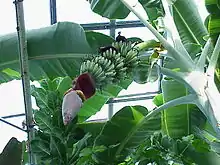
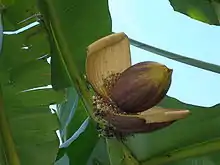


- M. acuminata Colla – wild seeded banana, one of the two main ancestors of modern edible banana cultivars
- M. acuminata subsp. zebrina [= M. sumatrana] – blood banana
- M. aurantiaca G.Mann ex Baker
- M. balbisiana Colla – wild seeded banana, one of the two main ancestors of modern edible banana cultivars
- M. banksii F.Muell.
- M. basjoo Siebold & Zucc. ex Iinuma – Japanese fiber banana, hardy banana[Note 3]
- M. cheesmanii N.W.Simmonds
- M. chunii Häkkinen
- M. griersonii Noltie
- M. itinerans Cheesman
- M. mannii H.Wendl. ex Baker
- M. nagensium Prain
- M. ochracea K.Sheph.
- M. ornata Roxb.
- Musa × paradisiaca L. = M. acuminata × M. balbisiana – many of the cultivated edible bananas
- M. rosea Baker
- M. rubinea Häkkinen & C.H.Teo
- M. rubra Wall. ex Kurz (syn. Musa laterita Cheesman)
- M. sanguinea Hook.f.
- M. schizocarpa N.W.Simmonds
- M. siamensis Häkkinen & Rich.H.Wallace
- M. sikkimensis Kurz
- M. thomsonii (King ex Baker) A.M.Cowan & Cowan
- M. velutina H.Wendl. & Drude – pink banana
- M. yunnanensis Häkkinen & H.Wang – Yunnan banana, wild forest banana
- M. zaifui Häkkinen & H.Wang
Section undetermined or unknown
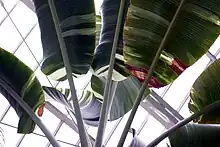
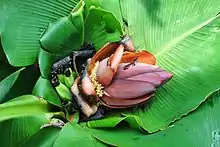
- M. arfakiana Argent
- M. arunachalensis A.Joe, Sreejith & M.Sabu
- M. celebica Warb. ex K.Schum.
- M. juwiniana Meekiong
- M. kattuvazhana K.C.Jacob
- M. lanceolata Warb. ex K.Schum.
- M. lutea R.V.Valmayor et al.
- M. sakaiana Meekiong et al.
- M. splendida A.Chev.
- M. tonkinensis R.V.Valmayor et al.
- M. yamiensis C.L.Yeh & J.H.Chen
Formerly placed here
- Ensete davyae (Stapf) Cheesman (as M. davyae Stapf)
- Ensete gilletii (De Wild.) Cheesman (as M. gilletii De Wild. or M. martretiana A.Chev.)
- Ensete glaucum (Roxb.) Cheesman (as M. glauca Roxb.)
- Ensete lasiocarpum (Franch.) Cheesman (as M. lasiocarpa Franch.) – also placed in a separate genus as Musella lasiocarpa (Franch.) C.Y.Wu ex H.W.Li[26]
- Ensete livingstoniana (J. Kirk) Cheesman (as M. livingstoniana J.Kirk)
- Ensete perrieri (Stapf) Cheesman (as M. perrieri Claverie)
- Ensete superbum (Roxb.) Cheesman (as M. superba Roxb.)
- Ensete ventricosum (Welw.) Cheesman (as M. arnoldiana De Wild., M. ensete J.F.Gmel. or M. ventricosum (Welw.) Cheesman)
- Heliconia bihai (L.) L. (as M. bihai L.)
Cultivated bananas

A number of distinct groups of plants bearing edible fruit have been developed from species of Musa. In English, fruits which are sweet and used for dessert are usually called "bananas", whereas starchier varieties used for cooking are called "plantains", but these terms do not have any botanical significance. By far the largest and now the most widely distributed group of cultivated bananas is derived from section Musa, particularly M. acuminata and M. balbisiana, either alone or in various hybrid combinations. The next but much smaller group is derived from members of section Callimusa (previously classified as Australimusa) and is restricted in importance to Polynesia. Of even more restricted importance are small groups of hybrids from Papua New Guinea; a group from section Musa to which Musa schizocarpa has also contributed, and a group of hybrids between section Musa and section Callimusa.
Banana and plantains are the fourth most produced food globally surpassed only by the staple crops of rice, wheat and maize.
Properties
Plants of the Musa spp. including roots, flowers and fruits have been used in the folk medicine cultures of Africa, Asia, India and the Americas. Modern studies examining the properties of the fruits have found diversity of bioactive compounds among genotypes compared with commercially grown cultivars.[27]
Section Musa cultivars
When the Linnaean binomial system was abandoned for cultivated bananas, an alternate genome-based system for the nomenclature of edible bananas in section Musa was devised. Thus, the plant previously known by the "species" name Musa cavendishii became Musa (AAA Group) 'Dwarf Cavendish'. The "new" name shows clearly that 'Dwarf Cavendish' is a triploid, with three sets of chromosomes, all derived from Musa acuminata, which is designated by the letter "A". When Musa balbisiana is involved, the letter "B" is used to denote its genome. Thus, the cultivar 'Rajapuri' may be called Musa (AAB Group) 'Rajapuri'. 'Rajapuri' is also a triploid, expected to have two sets of chromosomes from Musa acuminata and one from Musa balbisiana. In the genome of edible bananas from section Musa, combinations such as AA, BB, ABB, BBB and even AAAB can be found.
Fe'i-type cultivars
No such nomenclature system has been developed for the group of edible bananas derived from section Callimusa. This group is known generally as the "Fe'i" or "Fehi" bananas, and numerous cultivars are found in the South Pacific region. They are very distinctive plants with upright fruit bunches, featuring in three of Paul Gauguin's paintings. The flesh can be cooked before eating and is bright orange, with a high level of beta carotene. Fe'i bananas are no longer very important for food, as imported foods have grown in popularity, although some have ritual significance. Investigations are under way to use the Fe'i karat bananas (the name derives from "carrot" due to the intense orange-yellow color of the fruit) in prevention of childhood blindness in Pohnpei.[28] Fe'i bananas probably derive mainly from Musa maclayi, although their origins are not as well understood as the section Musa bananas. Cultivars can be formally named, as e.g. Musa (Fe'i Group) 'Utafun'.
Other uses
In addition to the edible fruits, the flowers can be eaten cooked, and the heart of the plant (like heart of palm) can be eaten raw or cooked. Additionally, the rootstocks and leaf sheaths of some species can be cooked and eaten.[29]
See also
- Ensete (false bananas); for more information about Musella, also see Musella lasiocarpa
- True plantains
Notes
- ↑ Arabic Mauz meaning Musa or banana is in the medieval Arabic medical encyclopedia by Avicenna, which is online at Avicenna: Book Two. See also "Musa" at Dictionary.Reference.com. See also Musacées in Dictionnaire Étymologique Des Mots Français D'Origine Orientale, by L. Marcel Devic (year 1876).
- ↑ Musa beccarii is reported as having a haploid chromosome number of 9 or 10, the latter due to multivalent formation during meiosis. Although genetically it nestles comfortably within section Callimusa the chromosome number needs clarification.
- ↑ Musa basjoo is the most cold hardy species of Musa, growing and fruiting successfully in outdoor cultivation in the British Isles and British Columbia.
References
- ↑ GRIN (2009-02-19). "Genus: Musa L." Taxonomy for Plants. National Germplasm Resources Laboratory, Beltsville, Maryland: USDA, ARS, National Genetic Resources Program. Archived from the original on 2012-10-11. Retrieved 2011-02-06.
- 1 2 Rouard, Mathieu, et al. “Morphology of Banana Plant.” The Banana Knowledge Platform of the ProMusa Network, Feb. 2019, www.promusa.org/Morphology+of+banana+plant.
- ↑ The Editors of Encyclopaedia Britannica. “Banana.” Encyclopædia Britannica, Encyclopædia Britannica, Inc., 22 Aug. 2019, www.britannica.com/plant/banana-plant.
- ↑ Davison, G. (November 1983). "Tahuka Anda?". Malayan Naturalist. 37 (2): 39.
- ↑ Judd, Walter S. Plant Systematics a Phylogenetic Approach. Sinauer Assoc., 2007.
- ↑ "Musa L." Plants of the World Online. Royal Botanic Gardens, Kew. Retrieved 12 February 2023.
- ↑ "Musa". World Checklist of Selected Plant Families. Royal Botanic Gardens, Kew. Retrieved 2013-01-10.
- ↑ Bailey, Liberty Hyde (1914–1917). The Standard Cyclopedia of Horticulture. Vol. 4.. New York: Macmillan. OCLC 2768915.. Pp. 2076–9.
- ↑ Denham, Tim; Donohue, Mark (2009). "Pre-Austronesian dispersal of banana cultivars West from New Guinea: Linguistic relics from Eastern Indonesia". Archaeology in Oceania. 44 (1): 18–28. doi:10.1002/j.1834-4453.2009.tb00041.x. Retrieved 5 Feb 2023.
- ↑ Donohue, Mark; Denham, Tim (2009). "Banana (Musa spp.) domestication in the Asia-Pacific Region: Linguistic and archaeobotanical perspectives". Ethnobotany Research & Applications. 7: 293–332. doi:10.17348/era.7.0.293-332. hdl:10440/942. Retrieved 5 Feb 2023.
- ↑ Blench, Roger (2016). "Things your classics master never told you: a borrowing from Trans New Guinea languages into Latin". Academia.edu.
- ↑ Entry Banana, at Dictionary.com.
- ↑ Sagot, M.P. (1887). "Sur le genre Bananier". Bulletin de la Société botanique de France. 34 (7): 328–330. doi:10.1080/00378941.1887.10830263.
- ↑ Baker, J.G. (1893). "A synopsis of the genera and species of Museae". Annals of Botany (Oxford). 7: 189–229.
- ↑ Cheesman, E.E. 1947 [pub. 1948]. Classification of the bananas. II. The genus Musa L. Kew Bull. 2: 106–117. doi:10.2307/4109207
- ↑ Argent, G.C.G. 1976. The wild bananas of Papua New Guinea. Notes Roy. Bot. Gard. Edinburgh 35: 77–114.
- ↑ Wong C, Kiew R, Argent GCG, Set O, Lee SK, Gan YY. Assessment of the validity of the sections in Musa (Musaceae) using AFLP. Ann Bot-London. 2002; 90: 231–238.
- 1 2 Häkkinen, Markku (2013). "Reappraisal of sectional taxonomy in Musa (Musaceae)". Taxon. 62 (4): 809–813. doi:10.12705/624.3.
- ↑ Feng, Huimin, et al. "Molecular Phylogeny of Genus Musa Determined by Simple Sequence Repeat Markers." Plant Genetic Resources, vol. 14, no. 3, 2015, pp. 192–199., doi:10.1017/s1479262115000222.
- ↑ Lamare, Animos; et al. (2017). "Phylogenetic Implications of the Internal Transcribed Spacers of NrDNA and Chloroplast DNA Fragments of Musa in Deciphering the Ambiguities Related to the Sectional Classification of the Genus". Genetic Resources and Crop Evolution. 64 (6): 1241–1251. doi:10.1007/s10722-016-0433-9. S2CID 20705065.
- ↑ Čížková, J; Hřibová, E; Christelová, P; Van den Houwe, I; Häkkinen, M; et al. (2015). "Molecular and Cytogenetic Characterization of Wild Musa Species". PLOS ONE. 10 (8): e0134096. Bibcode:2015PLoSO..1034096C. doi:10.1371/journal.pone.0134096. PMC 4529165. PMID 26252482.
- ↑ Search for "Musa". World Checklist of Selected Plant Families. Royal Botanic Gardens, Kew. Retrieved 2013-01-10.
- ↑ GRIN (2009-02-19). "Species in GRIN for genus Musa". Taxonomy for Plants. National Germplasm Resources Laboratory, Beltsville, Maryland: USDA, ARS, National Genetic Resources Program. Archived from the original on 2012-12-12. Retrieved 2011-02-06.
- ↑ Wong, C.; Kiew, R.; Argent, G.; Set, O.; Lee, S.K. & Gan, Y.Y. (2002). "Assessment of the Validity of the Sections in Musa (Musaceae) using ALFP". Annals of Botany. 90 (2): 231–238. doi:10.1093/aob/mcf170. PMC 4240415. PMID 12197520.
- ↑ Office of the Gene Technology Regulator (2008). The Biology of Musa L. (banana) (PDF). Australian Government.
- ↑ "Ensete lasiocarpum". World Checklist of Selected Plant Families. Royal Botanic Gardens, Kew. Retrieved 2013-01-10.
- ↑ Pearson, Valerie A. (2016). Bananas: Cultivation, Consumption and Crop Diseases. Nova Science Publishers. p. 1. ISBN 978-1-63485-418-4.
- ↑ Coghlan, Andy (2004-07-10). "Orange banana to boost kids' eyes". New Scientist.
- ↑ U.S. Department of the Army (2019). The Official U.S. Army Illustrated Guide to Edible Wild Plants. Guilford, CT: Lyons Press. p. 17. ISBN 978-1-4930-4039-1. OCLC 1043567121.
Further reading
- Hedrick, U.P. (ed.) (1919): Sturtevant's Edible Plants of the World. J.B. Lyon Co., Albany.
- Nelson, S.C.; Ploetz, R.C. & Kepler, A.K. (2006): Musa species (banana and plantain).
- Sharrock, Suzanne (2001). "Diversity in the genus Musa, focus on Australimusa" (PDF). INIBAP Annual Report. 2000: 14–19.
External links
- Musapedia, page on Musa wild species
- Musapedia, page on Musa sections
- Musapedia, page on the diversity of banana cultivars
- Musa basjoo photos
- Detailed discussion of bananas
- Musarama, banana image bank
- "Musa Germplasm Information System". Explore Banana Diversity. Retrieved 2021-12-28.
